How K-State research feeds the world
Transformation across the globe
For 160 years, Kansas State University has been feeding the world. As the nation’s first operational land-grant university, K-State continues to improve lives with global food systems research and service. Learn more about K-State people and projects that go beyond the boundaries of academic disciplines and the borders of countries.
Worldwide crops
Several K-State laboratories are focused on improving and protecting important worldwide crops, including millet, wheat, rice and maize.
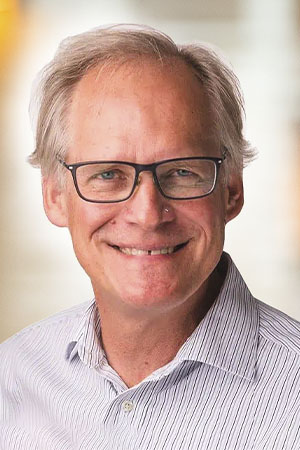 Tim Dalton, director of K-State’s Global Collaboration on Sorghum and Millet, or GCSM, studies how to increase food system productivity and add value to sorghum and millet products.
Tim Dalton, director of K-State’s Global Collaboration on Sorghum and Millet, or GCSM, studies how to increase food system productivity and add value to sorghum and millet products.
One collaborative innovation with scientists in Niger involves the pearl millet seed ball. This innovation can increase yields in the Sahel region of Africa, which includes harsh farming conditions such as poor soils, excessive heat and low and erratic rainfall. Seed balls are made of easily accessible products — soil, wood ash, seeds and some nutrients or pesticides — and are a low-cost, low-risk technology with potential for improved yields and farm profits.
“Across multiple years and thousands of farmers in Niger, we’ve seen yields between 20 to 30% and even higher in bad years,” said Dalton, also a professor of agricultural economics in the College of Agriculture. “Profitability has increased at a similar magnitude. This innovation creates more food and more income because of higher yields.”
Dalton has continued this important international work through GCSM, which was announced in June 2023. One of the collaboration’s first efforts is developing the national sorghum plan in Madagascar, where researchers say climate change is negatively affecting the production of two of the country’s most important crops: rice and maize.
But K-State scientists also are researching a worldwide crop closer to home.
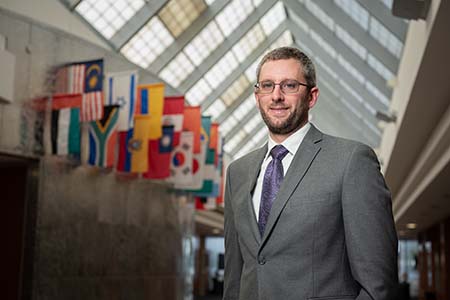 Jared Crain, research assistant professor of plant pathology, is studying wheat genomics. He was director of the Feed the Future Innovation Lab for Applied Wheat Genomics from May 2022 until its completion in August 2023, but has been involved with the lab since it began at K-State in 2013.
Jared Crain, research assistant professor of plant pathology, is studying wheat genomics. He was director of the Feed the Future Innovation Lab for Applied Wheat Genomics from May 2022 until its completion in August 2023, but has been involved with the lab since it began at K-State in 2013.
Crain partners with the International Maize and Wheat Improvement Center, which is based in Mexico but performs work across the world, including work in India and other Southeast Asian countries. The center extracts DNA from approximately 19,000 plants per year and ships them to K-State. Crain and his team process and sequence the DNA, then analyze it for elite traits, such as yield and resistance to heat, drought and disease, as well as desirable qualities for products that millers, bakers and consumers use.
“Based on how the varieties being released are scaling up, we think that in three years there could be more than 1 million acres in India planted with varieties that have been selected by and passed through this collaborative work,” Crain said.
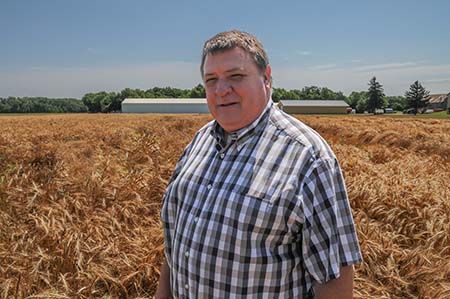 The wheat grown in Kansas is important worldwide, too. According to Allan Fritz, one of K-State’s wheat breeders and professor of agronomy, approximately 75% of wheat harvested in Kansas can be traced to K-State varieties. Until recent economic disruptions, such as the Russia-Ukraine war, Fritz estimated that Kansas exported approximately 50% of its wheat outside of the U.S. — proof that K-State work in the breadbasket of America also plays an important role in global wheat production.
The wheat grown in Kansas is important worldwide, too. According to Allan Fritz, one of K-State’s wheat breeders and professor of agronomy, approximately 75% of wheat harvested in Kansas can be traced to K-State varieties. Until recent economic disruptions, such as the Russia-Ukraine war, Fritz estimated that Kansas exported approximately 50% of its wheat outside of the U.S. — proof that K-State work in the breadbasket of America also plays an important role in global wheat production.
Increasing food production
Across the world, K-State researchers are changing lives through agricultural innovation.
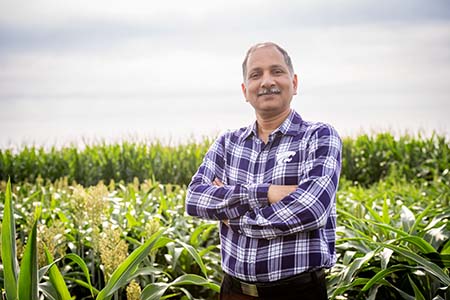 Vara Prasad directs the Feed the Future Innovation Lab for Collaborative Research on Sustainable Intensification, or SIIL, at K-State. He recently was named to Clarivate World’s Influential Researchers 2022 list, which recognizes the world’s top 1% of highly cited researchers.
Vara Prasad directs the Feed the Future Innovation Lab for Collaborative Research on Sustainable Intensification, or SIIL, at K-State. He recently was named to Clarivate World’s Influential Researchers 2022 list, which recognizes the world’s top 1% of highly cited researchers.
Under Prasad’s leadership, SIIL has four consortiums, four centers of excellence and many research projects in 13 different countries. The lab’s goal is to increase food production from existing farmland without damaging the environment. This involves crop management, agronomy and genetics, which includes developing new varieties, as well as socioeconomic intensification, which includes human and institutional capacity, environmental policy and product markets.
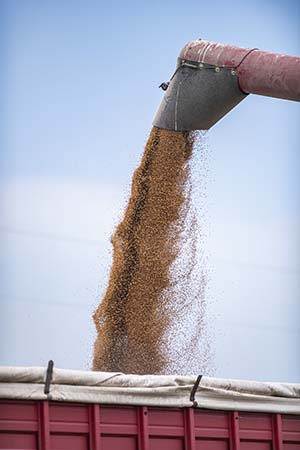 One of SIIL’s focus countries is Bangladesh, where researchers are identifying new crops — sunflowers, sesame or legumes such as mung beans — to grow between rice crops. One issue is a shortage of labor and the increased price of labor, which creates a need for mechanization.
One of SIIL’s focus countries is Bangladesh, where researchers are identifying new crops — sunflowers, sesame or legumes such as mung beans — to grow between rice crops. One issue is a shortage of labor and the increased price of labor, which creates a need for mechanization.
“If we are able to achieve more efficient planting and harvesting methods, that will save farmers time and allow for another short-duration crop to be planted and harvested in the 60 to 90 days between rice crops,” said Prasad, also a university distinguished professor of agronomy and the R.O. Kruse professor in the College of Agriculture.
Prasad is proud that SIIL has trained around 230 students and many now work at universities, research centers and in industry worldwide.
“At the end of the day what we do must impact people — it’s about lives and the livelihoods of people,” Prasad said.
Importance of safe food
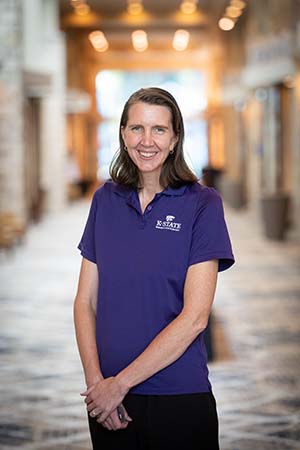 Londa Nwadike has a lengthy career conducting food safety research, including work in developing countries through the United Nations Food and Agriculture Organization as well as project collaboration on food safety in markets in Cambodia and Bangladesh.
Londa Nwadike has a lengthy career conducting food safety research, including work in developing countries through the United Nations Food and Agriculture Organization as well as project collaboration on food safety in markets in Cambodia and Bangladesh.
In her role as extension associate professor of food safety for K-State and the University of Missouri, Nwadike is working with refugees from across the world who are living in the Kansas City area. She is helping them understand food safety requirements as they participate as both growers and consumers in local farmers markets.
Through her research and K-State Research and Extension work, Nwadike is a strong advocate for the importance of food safety to the global system.
“We want people to have food, but it must be safe,” said Nwadike, who works at the K-State Olathe campus. “We can produce food all day long but if it’s not safe, people can get sick from it and might not be able to sell it. Neither having no food nor having foodborne illness are good situations.”
Challenges with conservation
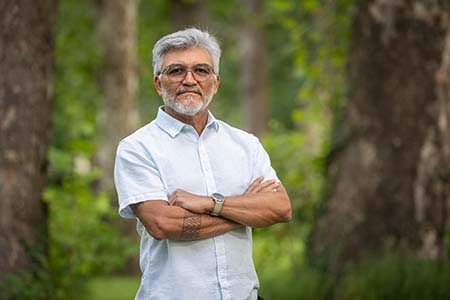 An important piece of the global food system is conservation, biodiversity, land use and land cover change — all areas that interest Marcellus Caldas, professor of geography and geospatial sciences in the College of Arts and Sciences.
An important piece of the global food system is conservation, biodiversity, land use and land cover change — all areas that interest Marcellus Caldas, professor of geography and geospatial sciences in the College of Arts and Sciences.
Caldas has been involved in multiple projects in his home country of Brazil, including recently published research in the journal Science with colleagues from Brazil and Spain.
The research looked at how conservation policies in Brazil, such as the Forest Code and Native Vegetation Protection Law, have positively affected areas like the Brazilian Cerrado. The area is a tropical savanna southeast of the Amazon rainforest that is rich in biodiversity, but a significant portion of the land has been converted to use for crop production and cattle ranching. The researchers found that private protected areas accommodate up to 14.5% of threatened vertebrate species ranges, which increases to 25% when considering the distribution of remaining native habitat.
While the laws seem to be helping biodiversity, Caldas said farmers don’t receive any compensation for doing this, which has led to pressures to change the law. He said offering incentives to farmers could be a solution, and gave the example of the U.S. Department of Agriculture Conservation Reserve Program, which offers a yearly rental payment to farmers for removing environmentally sensitive land from agricultural production.
“In a place that is considered a breadbasket such as the Cerrado, farmers are going to want to put more land in production,” said Caldas, also the assistant provost for international faculty collaboration and educational programs in the Office of International Programs at K-State. “If you want to convince the farmers to set aside their land then you must create incentives for them to do so.”
Making acceptable food makes a difference
We’ve all begrudgingly eaten or tried food that we’re not sure about — maybe we eat vegetables to be healthier or perhaps we try a new dish outside of our comfort zone.
Edgar Chambers IV, university distinguished professor of food, nutrition, dietetics and health in the College of Health and Human Sciences, wants to make food more acceptable to consumers across the world.
“Sensory analysis and consumer behavior are important because people don’t eat or use products they don’t like,” said Chambers, who also directs the K-State Sensory Analysis Center. “In one study, we literally saw children spit out food and refuse to eat more because it didn’t taste good. Parents refused to take more of it even when it was offered for free.”
In another study, Chambers examined how different cultures accepted insect-based foods. The results showed that people in Mexico and Thailand were more willing to accept them than people in the U.S., Japan, Spain and Australia. In another similar study, he found that adding 10-20% of insect powder into chocolate chip cookies was liked as well as a regular cookie in the U.S. and Spain, and it was preferred in Mexico when the insect powder’s presence was unknown.
“This told us that it was not a matter of bad flavor, texture or appearance, but rather of perception of eating a product containing insects,” Chambers said.
Another project in Tanzania has aimed to develop a sorghum-based porridge to be used in feeding programs for young children, many of whom are malnourished. The researchers have stories of young children who are now living healthy lives and of families who have been reunited through the program.
“The results of the project were good in terms of creating an appropriate, good-tasting food from sorghum, but the human impact was much greater than that,” Chambers said.
View additional resources and websites that detail K-State’s work across the globe.
- Feed the Future Innovation Lab for Collaborative Research on Sustainable Intensification
- Feed the Future Innovation Lab for the Reduction of Post-Harvest Loss
- Feed the Future Innovation Lab for Applied Wheat Genomics
- Feed the Future Innovation Lab for Collaborative Research on Sorghum and Millet
- Global Food Systems
- Global Foods Systems Leadership
- Henry C. Gardiner Global Food Systems Lecture Series
- Global Food Systems Seed Grant Program